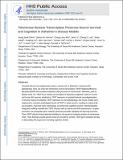Telomerase reverse transcriptase preserves neuron survival and cognition in Alzheimer’s disease models
Author(s)
Shim, Hong Seok; Horner, James W; Wu, Chang-Jiun; Li, Jiexi; Lan, Zheng D; Jiang, Shan; Xu, Xueping; Hsu, Wen-Hao; Zal, Tomasz; Flores, Ivonne I; Deng, Pingna; Lin, Yuan-Ta; Tsai, Li-Huei; Wang, Y Alan; DePinho, Ronald A; ... Show more Show less
DownloadAccepted version (3.804Mb)
Open Access Policy
Open Access Policy
Creative Commons Attribution-Noncommercial-Share Alike
Terms of use
Metadata
Show full item recordAbstract
Amyloid-induced neurodegeneration plays a central role in Alzheimer's disease (AD) pathogenesis. Here, we show that telomerase reverse transcriptase (TERT) haploinsufficiency decreases BDNF and increases amyloid-β (Aβ) precursor in murine brain. Moreover, prior to disease onset, the TERT locus sustains accumulation of repressive epigenetic marks in murine and human AD neurons, implicating TERT repression in amyloid-induced neurodegeneration. To test the impact of sustained TERT expression on AD pathobiology, AD mouse models were engineered to maintain physiological levels of TERT in adult neurons, resulting in reduced Aβ accumulation, improved spine morphology, and preserved cognitive function. Mechanistically, integrated profiling revealed that TERT interacts with β-catenin and RNA polymerase II at gene promoters and upregulates gene networks governing synaptic signaling and learning processes. These TERT-directed transcriptional activities do not require its catalytic activity nor telomerase RNA. These findings provide genetic proof-of-concept for somatic TERT gene activation therapy in attenuating AD progression including cognitive decline.
Date issued
2021Department
Massachusetts Institute of Technology. Department of Brain and Cognitive SciencesJournal
Nature Aging
Publisher
Springer Science and Business Media LLC
Citation
Shim, Hong Seok, Horner, James W, Wu, Chang-Jiun, Li, Jiexi, Lan, Zheng D et al. 2021. "Telomerase reverse transcriptase preserves neuron survival and cognition in Alzheimer’s disease models." Nature Aging, 1 (12).
Version: Author's final manuscript